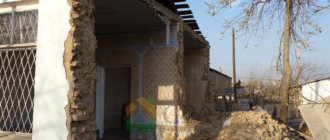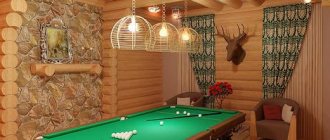Redevelopment of a private house is started if the space in the room is distributed irrationally and inconveniently. This can be fixed in two ways:
- add new premises
- completely change the interior layout
Homeowners, unlike apartment residents, do not have neighbors who may have a claim due to the demolition of a wall or the removal of a bathtub. But redevelopment of a residential building must be legal. All significant changes are approved by regulatory authorities - follow the link to read how to do this and what documents are required. This article tells:
- Which houses can be remodeled?
- How should the rooms in the house be located?
- Home remodeling projects
- A real example of a successful redevelopment of an old house
Legislative framework of the issue
The concept of redevelopment of residential premises is disclosed in the Housing Code of the Russian Federation.
In accordance with the law, this term implies a change in the configuration of the premises, which must be included in the technical passport of the facility.
The concept of redevelopment and the definition of its illegality are enshrined in Articles 25-29 of the Housing Code of the Russian Federation. The regulation of the procedure for legalizing redevelopment is regulated by Government Resolution No. 266. It contains an application form for the procedure.
Carrying out repair and construction work without the consent of authorized organizations is punishable under the Code of Administrative Offences.
What can you do without obtaining permission?
Not all repair and construction work on redevelopment of premises requires approval.
There are a number of activities that can be carried out without obtaining permission :
- The owner of the house can independently make cosmetic repairs to the room, re-glue the wallpaper, and re-lay the floor coverings.
- The installation of gas stoves, plumbing fixtures, and heating appliances does not require approval.
- Sealing doorways in load-bearing walls.
- Removing partitions that are not load-bearing.
- Making additional doorways in interior partitions.
- Changing the vestibule, if it does not concern an increase in size.
If the planned changes do not pose a risk of building collapse, they are not subject to the ban.
Why is it necessary to coordinate redevelopment in a private house or cottage?
- I want to live and understand that the real estate is legitimate. Stop being nervous and thinking that the redevelopment carried out in a private house or cottage has not been agreed upon and will sooner or later become a problem when selling or exchanging;
- An inspection inspector from a supervisory organization or an engineer from a management company came and issued an order stating that it was necessary to provide a package of documents within a month for approval of the reconstruction of a private house or cottage;
- We decided to sell or buy real estate in a private house or cottage, but were faced with the fact that there is an illegal redevelopment and it is necessary to understand how much it will cost to legalize it or whether it is possible to approve such a redevelopment on the site;
- Conflict with neighbors or the management company and there is no understanding of what it can lead to, since the situation is aggravated by illegal redevelopment and reconstruction;
- You need a loan secured by real estate, but it is not given due to illegal reconstruction;
- Do you want to sell a private house or cottage, but are faced with constant refusals from buyers due to illegal redevelopment;
- The bank refuses to provide a mortgage for the purchase of a private house or cottage due to identified violations in reconstruction and redevelopment;
- Litigation regarding a private house, cottage, initiated by an insurance company, management company or neighbors. Liquid real estate will give you a better chance of winning the process.
Features of modernization of suburban buildings
Wooden buildings, despite positive reviews, need to be repaired. After long-term use, even a home built according to all the rules deteriorates. Selling or breaking down and then buying or rebuilding is not an option for everyone. It’s easier and cheaper to try to make a modern cottage out of an outdated house. Although even when remodeling, you need to be prepared for big expenses, the amount of which depends on the deterioration of the building. When the project involves not partial, but global reconstruction - increasing the area, replacing the materials of walls, roofing, flooring, communications - you should prepare a tidy sum.
Also keep in mind that if the project of remodeling an old wooden house can still be done independently, then it is better to call a professional to assess the technical condition and determine the parts that must be replaced. For a competent, experienced remodeler, this is an easy task.
How to breathe new life into an old house
You can modernize a wooden house with the help of builders or yourself. If you turn the project into reality with your own hands, you can save a lot and spend the remaining money on material. It is only important to know the stages of remodeling and carry out each step in compliance with building regulations.
Difference from reconstruction
The concepts of redevelopment and reconstruction are different.
Reconstruction of a private house is a technical change in the external parts of the building (Part 14, Article 1 of the Civil Code of the Russian Federation). For example, installing an extension or adding a floor. Due to such work, the total area of the house changes - often upward. Changes are recorded in cadastral registration.
Redevelopment is construction work inside a residential building. It does not affect external walls and does not provide for the creation of an attic or an extension. Remodeling may involve remodeling, but these are usually two separate activities.
Changes on the outside
External redevelopment involves making changes to the facade of the building. External repair work includes:
- changing the façade architecture;
- changing the color scheme of the house;
- moving the front door and window structures;
- creation of new window and door openings;
- covered roofs of the house;
- construction of new or removal of old buildings;
- elimination of window openings, etc.
Attention! Changing the color of the facade and finishing it with modern building materials will not require permission from the authorities and can be done without permission.
Do I need permission to redevelop a private house?
Yes, without fail. The permit is issued at the stage of coordination of the redevelopment of a private house with the executive authority.
What work requires a permit:
- Moving the kitchen into the living room.
- Removing partitions between rooms.
- Creation of a new bathroom (with installation of utilities).
- Construction of new walls.
- Construction of an opening in the load-bearing wall of a private house.
- Replacement of the floor, with hydro- or sound insulation.
- Cutting new windows and doors.
- Replacement of the rafter system in the attic, etc.
Why do you need to obtain permission for redevelopment? After all, the house is private, not multi-apartment. Many people think that any redevelopment can be done at the discretion of the owner. However, there are fire safety, building and hygiene standards. For example, if you tear down a load-bearing wall, the house will collapse. If you don't take care of fire safety in the kitchen, the house could catch fire. That is why you need to coordinate future redevelopment with specialists. And always take into account SNiPs, SanPiN standards, GOSTs, etc.
Redevelopment or reconstruction are works that are reflected in the BTI plan. This includes dismantling partitions, moving plumbing fixtures, and new doorways in load-bearing walls. If the work is not shown on the apartment plan, it is not a redevelopment. There is no need to coordinate them - even if you come to the housing inspectorate with such a request, they will not provide the service.
Sometimes it happens like this: people think that they are doing a serious, major renovation and it must be approved by the housing inspectorate, but in reality there is no need for any design documentation, just like ordering a BTI plan, paying fees and waiting for permission. You can simply make repairs without contacting any authorities.
Criteria by which you can understand that approval from the housing inspectorate is not required:
- the partitions inside the apartment remain in place;
- door and window openings remain in place;
- the doors themselves remain where they are provided for on the BTI plan;
- the floor design does not change;
- plumbing, pipes, gas pipelines - everything remains in place.
- Examples of work that do not need to be approved:
- replacing electrical wiring when walls need to be tapped;
- laying new pipes for the bathroom;
- leveling walls for painting or wallpaper;
- installation of new doors;
- window replacement;
- replacement of bathtub, toilet, sink, sink;
- finishing the room - painting walls, replacing wallpaper and ceiling coverings.
These works are not considered redevelopment and do not require approval even if the apartment owner wishes.
There are a number of minor repairs that, if desired, can be agreed upon with the housing inspectorate, but in fact this will be unnecessary trouble. If you do them without permission, there will be no problems - neither when selling the apartment, nor when renting it out.
- These are the works we are talking about:
- installation of a built-in wardrobe;
- dismantling the built-in wardrobe;
- balcony glazing device;
- dismantling balcony glazing.
If the entire renovation consists of a built-in wardrobe or replacement of glazing on the balcony and there is no serious redevelopment that certainly requires approval, in practice you can do without obtaining permission from the housing inspectorate and drawing up a refurbishment act. Major renovations include combining a bathroom, changing the configuration of rooms, and moving doorways.
Is the project needed?
Minor changes can be agreed upon according to the sketch; for large-scale redevelopments, special projects are developed. Such documents are created by organizations licensed to carry out activities of this kind.
In what cases is a project necessary:
- if load-bearing walls change;
- when adding stairs, balconies, loggias or changing them;
- installing bathrooms or changing their location;
- when installing partitions that will increase the load on the floors;
- installation of roller shutters, glazing of balconies (loggias);
- facade - changes in architectural, color scheme, configuration.
Coordination of redevelopment of a residential building
The approval procedure includes several stages. Most of it coincides with the procedure for obtaining permission to redevelop an apartment in an apartment building.
Where to contact
So, to coordinate repair work in a private house, you need to contact:
To the City Executive Committee - usually there are departments for architecture, where you need to submit an application;
To the village administration - for redevelopment of houses in the village;
In the MFC “My Documents” there is an intermediary body, through which you can transfer the application and documents to the local administration, to the Unified State Register of Real Estate;
At the BTI, they issue a technical passport and record the current and new redevelopment of a private house. It is more convenient to apply through the MFC. This can be done in any “My Documents” branch, regardless of the place of registration.
In many cities, the administration accepts applications only through the MFC.
Algorithm of actions
How to coordinate the redevelopment of a private house before starting work:
- Decide on a design project or sketch.
- Order a technical passport or technical plan of a private house from BTI. To do this, you need to contact the Bureau and pay for the service. If the previous registration certificate is more than 5 years old, you will have to order a new one. Otherwise, the administration may refuse to issue a permit.
- Contact a design organization and order a redevelopment project for a private house. It is important that the organization has access to SRO to carry out design work.
- Get a finished project. It consists of several sheets that indicate the characteristics of the house, future work, safety requirements, diagrams, drawings and other information.
- In some cases, a technical opinion is needed. It can be ordered from the same organization where the project was created.
- Contact the MFC or the administration to obtain permission for redevelopment.
- Get permission.
- Remodel a private house. There should be no deviations from the developed project, otherwise the repair will not be approved.
- Contact the MFC with an application to issue a certificate of completed redevelopment.
- Submit the work to the acceptance committee. They will make sure that the repair meets all points of the project, there are no discrepancies or violations of safety requirements. If everything is in order, they will sign an act of completed redevelopment.
- Order new measurements from BTI or Rosreestr.
- Submit the technical plan and other documents through the MFC for cadastral registration. It is handled by FKP Rosreestr. If everything is fine with the documents, changes will be made to the database, and the owner of the house will receive an extract from the Unified State Register of Real Estate.
The stages of the procedure and coordination with government agencies may differ depending on your region of residence.
Transformation of a dilapidated building into modern housing: before and after photos
Converting an old house to a new one is neither easy nor quick. But about a year after the start of work, you can achieve an amazing result. And become the owner of a wonderful home in the same place.
To prove these words, look at the house designs before and after renovations. Then you will understand that all this is not fantasy.
All wooden houses wear out after 40-50 years of use and require extensive repairs or reconstruction. You shouldn't be afraid of this. Modern technologies and materials will help breathe a second life into any home, making it durable, beautiful and cozy.
Documents for house redevelopment
The list of documents is as follows:
- passport - needed to apply to the MFC and BTI;
- redevelopment project for a private house or sketch;
- documents for a residential building - an extract from the Unified State Register or a certificate of ownership;
- technical certificate of the building; application of the established form - the form will be issued at the MFC.
They may also require permission from government agencies. For example, Gospezhnadzor, SES, Department of Architecture, BTI and others. If you have entrusted the approval to a representative, prepare a power of attorney in his name. Processing time Permission to redevelop a private house is issued within 45 days. And a little longer if you applied through the MFC. Add another 3-4 days to this period for sending documents.
Issuance of other documents and the project is always individual. On average, it takes 3-4 months to approve redevelopment in a private house.
Price
There is no need to pay for the issuance of a permit from the administration - this is a free service. Other documents are paid:
- Redevelopment project - in the regions about 3,000 - 5,000 thousand rubles, in Moscow, Moscow region and St. Petersburg - from 5,000 to 40,000 rubles, depending on the complexity of the architectural solution.
- Registration certificate for a house - within 1,000 rubles.
- Extracts from the Unified State Register of Real Estate – from 460 rubles.
- Notarized power of attorney – about 1,500 rubles.
- Permits from the bank and insurance company - from 2,000 to 5,000 rubles.
- Of course, there may be other costs. Moreover, this is only for the approval of redevelopment with a government agency. Costs for building materials and repairs vary individually.
Reinforced concrete floors
They are divided into monolithic and prefabricated.
Monolithic floors until the mid-90s. XX century had very limited use. These limitations were determined by the lack of reversible formwork, as well as mechanisms that would allow the concrete mixture to be transported throughout the building being constructed.
Until 1924, monolithic floors were installed in residential buildings up to five floors high, mainly above the basement floor, as well as on above-ground floors in the areas where bathrooms and kitchens were located. A monolithic slab of reinforced concrete on crushed brick was made along the top flange of rolled metal beams.
Starting from the mid-1930s, with an increase in the number of storeys, based on current fire safety standards, it became necessary to create fireproof fireproof diaphragms along the height of the building in some buildings under construction.
Such diaphragms made of monolithic concrete were installed above the basement, third, fourth and top floors. Rolled metal beams were used as the main load-bearing elements. A monolithic reinforced concrete slab was placed on both the upper and lower flanges of the beams.
The initial period of prefabricated reinforced concrete construction was based on the use of small-sized ribbed slabs of the PRT type on rolled metal beams.
Since the mid-1950s. In the 20th century, new construction switched to prefabricated reinforced concrete - along reinforced concrete girders of rectangular or T-section.
In prefabricated houses (after the 1960s), three types of reinforced concrete floors were used: composite, solid, and void slabs.
When repairing ceilings, the following types of work are performed:
- selective change of floors;
- strengthening of wooden and steel beams;
- unloading load-bearing elements of floors.
Wooden floors
Floors of this type have long been popular in private construction. This is an affordable, environmentally friendly material that is lightweight and has a pleasant appearance. The load-bearing element in such a floor is beams in the form of logs or beams. They must meet all the necessary characteristics, including deflection indicators (it is better to have a reserve).
Also, the reliability and characteristics of the finished floor depend on its type. For example, they can be made of solid wood, have a composite section, or even be a two-level structure.
Since the beams bear the main load, it is important to take into account their cross-section. It is selected based on the distances between load-bearing walls. The structure can contain either just beams or logs, on which boards are subsequently laid. If you decide to install only beams, then this design will be less expensive, but will not provide protection from impact noise. That is, any movement of people on the floors can be clearly heard. If logs are first laid on the beams, then soundproofing material is installed between them. Therefore there will be no noise.
The ceiling itself is made of the so-called roll. It is a wooden flooring made of panels or boards, which is placed between the beams. Ceiling decoration can be very diverse. Some people do the usual plastering, but a more progressive solution would be to cover its surface with plasterboard slabs.
Pros and cons of wooden floors
If we talk about the advantages of this type of construction, it is worth highlighting that they:
- They are distinguished by the low cost of both the material itself and delivery and installation work.
- Excellent for lightweight substrates.
- Used in “difficult” soil conditions.
- Can be installed manually, without specialized equipment or builders.
- Easy and quick to install.
- Environmentally friendly. The wood does not contain any aggressive drugs, there is no reinforcement.
Healthy! When purchasing material, you need to carefully inspect all beams. There should be no cracks or signs of parasite infestation.
On the other hand, such designs have a lot of disadvantages. For example,:
- The tree can be chewed by rodents or insects. It is susceptible to mold and mildew.
- Treatment with special preservative compounds is required. Otherwise, the wood will rot. Periodically it is necessary to impregnate the wood with antiseptics. However, even if you perform high-quality wood processing, you will not receive 100% protection from rot. Also, to prevent the process of rotting, you will need to organize a high-quality ventilation system.
- The beams will have to be sheathed on both sides, and the space between them must be filled with insulation and sound insulation.
- Laying wooden elements requires a lot of effort and time.
- The service life of such structures is much shorter than that of concrete ones. In addition, over time, the wood will begin to sag a little, and creaking may appear.
- Wooden floors are not recommended for use in the construction of multi-storey buildings, as well as if the building is located in a seismic zone, where the indicators reach up to 7 points.
- Since wood is easily flammable, the beams will also have to be treated with fire retardants. Or you can use special fire-retardant varnishes or paints.
- If the span is quite large (more than 6 meters), then in this case the structure will require reinforcement, and therefore additional materials. It will be necessary to buy beams with a large cross section. This means that the thickness of the entire overlap will be increased.
- Such products cannot be used in damp areas. This means that reinforced concrete structures must be used for showers, toilets, laundry rooms and bathrooms.
- In those places where the ceilings are adjacent to the chimney, you will have to make thermal insulation joints.
Therefore, if finances allow, and especially if we are talking about building several floors, then it is worth considering the option of reinforced concrete structures.
Basic requirements for floors
The installation of such structures is subject to special requirements regarding the degree of sound insulation, heat protection and fire resistance. To achieve good sound insulation, it is necessary to hermetically seal the cracks and joints formed between the sheets of material. Rooms with different temperature conditions are equipped with additional thermal insulation; this must be taken into account before finally choosing which floors to use for the second floor. Regardless of what material they are made of, an important stage of construction is protecting the floors from fire.










